King County posts record transit ridership in year of bus and train expansion
Summary
Transit ridership across King County Metro and Sound Transit climbed to its highest levels ever, totaling about 150 million rides in the King County area in 2016. The Seattle area leads the nation in ridership growth compared to the largest metro areas in the U.S. Strong ridership between Metro and Sound Transit highlights significant progress on King County Executive Dow Constantine’s priority of integrating the region’s transit network.
Story
 An estimated 150 million people rode Metro bus service, Link light rail and ST Express service operated by Metro in 2016, a 5 percent ridership growth rate that helped propel the Seattle area to lead the nation in ridership growth compared to the other largest metro areas in the U.S., according to national transit data.
An estimated 150 million people rode Metro bus service, Link light rail and ST Express service operated by Metro in 2016, a 5 percent ridership growth rate that helped propel the Seattle area to lead the nation in ridership growth compared to the other largest metro areas in the U.S., according to national transit data.
Sound Transit Link light rail ridership rose to 19.1 million rides, Metro Transit marked a second consecutive year of nearly 122 million rides, and ST Express routes operated by Metro carried 9.7 million riders. Coordinating schedules and operations between Metro and Sound Transit helped customers travel smoothly to work, school, appointments and entertainment.
"Transit ridership continues to grow, and we’re meeting the need by offering more and better service, improving reliability, and making transfers between bus and rail as simple as possible," said King County Executive Dow Constantine. "More mobility means better quality of life, and this year we expect thousands of new riders to reclaim precious time and money by leaving the car by the curb and joining their neighbors on transit."
Seventy percent of commuters to downtown Seattle report they take transit, bike, walk or telecommute, according to a Commute Seattle survey released this month.
In spring 2016, Metro Transit restructured bus service to improve neighborhood frequency and connect riders to train stations in response to Sound Transit’s Link light rail extensions to Capitol Hill and UW at Husky Stadium. Those bus changes affected nearly one-third of Metro’s operating hours, primarily in Northeast Seattle and Capitol Hill.
Ridership data collected in the months following the service change last spring shows a net increase of 5 percent on Metro and Sound Transit services even as there are 8 percent fewer (-9,600) riders on Metro bus routes in the areas where Link light rail expanded, which was expected as some riders opt for new, more reliable train service.
Outside of the areas immediately around Link stations, Metro saw growing use of the more frequent neighborhood bus network in Northeast Seattle. In the Bryant neighborhood, for example, there are more than 800 additional weekday riders. Route 372 between Bothell, Lake City and the University District has thousands of additional riders. Ridership in the Maple Leaf neighborhood has climbed by 6 percent.
Metro continues to monitor ridership and system performance, and analyze crowding and reliability. These initial ridership figures are expected to be updated and receive further analysis this spring. Over time, ridership is estimated to grow by millions of additional annual trips as more riders learn about and become accustomed to the revised and improved network.
Rider satisfaction survey information also is under analysis, with preliminary information pointing to an improvement in overall satisfaction since changing the service network. More refinement remains to serve existing and ongoing demand, and Metro’s two-year budget includes additional service to address reliability and crowding, beginning with the March 11 service change.
Ridership by the numbers
Metro Transit: 121.5 million in 2016 (121.8 million in 2015) for Metro buses, DART and SLU Streetcar
Sound Transit: 42.7 million across Link light rail, Sounder, Sound Transit Express and paratransit (34.7 million in 2015)
Metro RapidRide: 20.7 million riders on six routes, 10 percent higher than 2015.
Average RapidRide weekday ridership:
- A Line: 10,180
- B Line: 6,700
- C Line: 10,690
- D Line: 14,060
- E Line: 17,380
- F Line: 5,850
Metro vanpools: 3.5 million in 2016 (3.5 million in 2015)
Metro Access: 960,000 in 2016 (990,000 in 2015)
Relevant links
Quotes
Transit ridership continues to grow, and we’re meeting the need by offering more and better service, improving reliability, and making transfers between bus and rail as simple as possible. More mobility means better quality of life, and this year we expect thousands of new riders to reclaim precious time and money by leaving the car by the curb and joining their neighbors on transit.
Dow Constantine, King County Executive
For more information, contact:
Alex Fryer, Executive Office, 206-477-7966

 Translate
Translate

